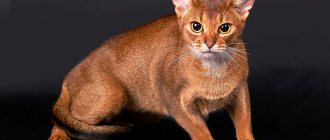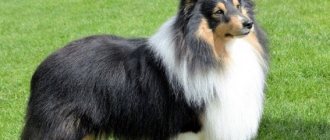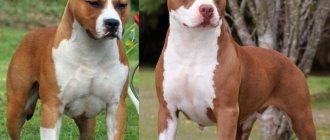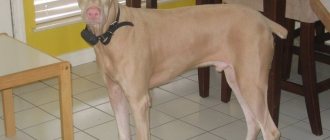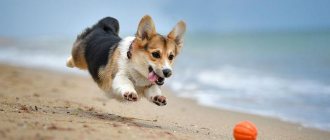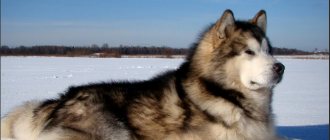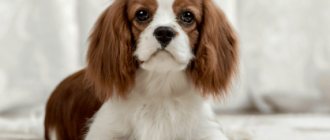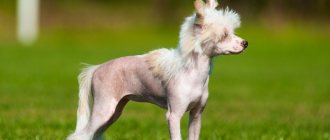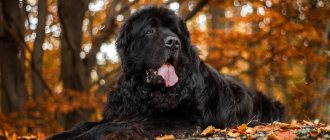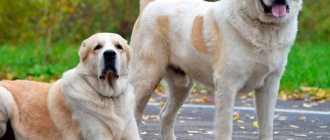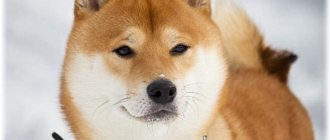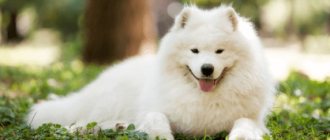Breed traits
Breed traits (on a 5-point scale)
| American Staffordshire Terrier | |||
| Activity | in the house | 3.3 | |
| on the street | 4.7 | ||
| Obedience | training | 3.3 | |
| strangers | 3.3 | ||
| Domination | in family | 2.3 | |
| over dogs | 4.3 | ||
| Defending your territory | from people | 3 | |
| from dogs | 4.3 | ||
| Sociability | in family | 5 | |
| with strangers | 2.7 | ||
| with dogs | 2.7 | ||
| Concentration | in family | 1 | |
| in front of strangers | 2.7 | ||
| with dogs | 2.7 | ||
| Aggressiveness | in family | 1 | |
| to strangers | 2 | ||
| to the dogs | 2.3 | ||
| to cats | 3 | ||
| Family behavior | calmness | 4.3 | |
| demand for affection | 5 | ||
| excitability | 4 | ||
| playfulness | 4.7 | ||
| excessive barking | 1 | ||
| behavioral breakdowns | 3 | ||
| Tolerance for children | up to 4 years | 4.3 | |
| over 4 years old | 4.3 | ||
| Institutional use | watchman | 4 | |
| bodyguard | 3.3 | ||
This breed is often compared to the following dog breeds: Cane Corso, German Shepherd, Rottweiler, Doberman (Doberman Pinscher), Staffordshire Bull Terrier.
Photos of American Staffordshire Terriers:
American Staffordshire Terrier
American Staffordshire Terrier
Feeding ration
The diet of the Staffordshire Gray Terrier with blue eyes is no different from that of representatives of other coat shades. The main recommendation in feeding is the regimen. Feeding the dog should be done at a precise time and depending on the age. Puppies eat frequently; an adult animal only needs one meal, preferably in the evening.
Meat and offal should predominate in feeding. A quarter of the diet consists of cereals and vegetables. When feeding dry foods, you should follow the instructions for their use. It is forbidden to feed the dog sweets, smoked meats and pickles.
American Staffordshire Terriers: general characteristics of the breed
The American Staffordshire Terrier is capable of becoming a devoted friend and companion. Thanks to his strength, fearlessness and intelligence, he can cope with any job. This dog loves to spend time with its owner, accompanying him during travel and sports training. The pet will fearlessly protect family members from any threats and will become a faithful friend to the child.
Despite its intimidating appearance, it is a family dog, loyal and flexible. The belief that the Staffordshire Terrier is a killer arose from its previous use in dog fighting. But during the breeding process, aggressive individuals were rejected. Therefore, now the uncontrollability of the staff is the result of improper upbringing. But there is no anger in his nature. Not everyone can have this breed. Only an experienced owner can cope with a stubborn, willful and independent dog.
With proper training, the American Staffordshire Terrier becomes the best bodyguard, watchman and security guard. Farmers use these dogs to look after livestock and kill rats. They are universal - they can become guides for the blind, serve as rescuers, and participate in the search for terrorists.
| Options | Characteristic |
| country of origin | USA |
| year of breed registration | 1936 |
| height | males – 46-48 cm, females – 44-46 cm |
| weight | males 25-30 kg, females 23-27 kg |
| life expectancy | 10-12 years |
| working qualities | good guard, watchman, companion |
| aggressiveness | high |
| activity | high |
| intelligence | average |
| ability to train | smart, obedient |
| relationship with the owner | loyal, friendly, does not tolerate loneliness well |
| need for care | minimal, sheds little |
| health | average |
The photo complements the characteristics of these dogs:
Amstaff in winter
Give me a paw friend...
Pros of the breed
This breed is one of the ten most popular in the world. Staffordshire Terriers are bred not only to guard the home, but also as pets. These dogs have many advantages:
- medium size allows you to keep it in an apartment;
- stable psyche, it is difficult to anger them;
- easy to train, smart and obedient;
- hardy, efficient, active, can be taught agility, canicross;
- care is simple, the dog is clean and unpretentious;
- good security qualities, protects family members from any threat;
- rarely raise a voice;
- loyal to the owner, sociable, friendly;
- get along well with children.
Cons of the breed
Staffordshire Terriers are dogs that are not suitable for couch potatoes or weak-willed people. It will be difficult for women, children, and elderly people to cope with them. Before getting a dog of this breed, you need to know about their disadvantages:
- stubborn, independent, strive for leadership;
- requires serious education;
- need high physical activity;
- prone to aggression and are wary of strangers;
- you need to walk in the city on a leash, preferably with a muzzle;
- susceptible to joint diseases and obesity.
If the staff starts to fight with another dog or rushes at someone, it is difficult to pull him away. This dog is stubborn, has a strong grip, and will fight to the bitter end. Therefore, representatives of the breed are considered dangerous.
Interesting Facts
Despite the fact that these dogs are considered aggressive, their popularity throughout the world is great. Over almost two centuries of the breed's existence, many interesting facts about Staffordshire Terriers have accumulated.
- Dogs of this breed often serve in the police and the Ministry of Emergency Situations. They look for explosives and save people.
- Staff puppies are constantly chewing something. To preserve things, you need to give them chewing bones.
- The fighting qualities of these dogs are preserved genetically. Therefore, they require constant monitoring.
- From their ancestors - English terriers - Staffs inherited the ability to hunt rats.
- There is a Ukrainian clothing brand called staff.
An interesting video will tell you in detail about the pros and cons of these dogs:
History of origin of the Staffordshire Terrier breed
Despite the name, the country of origin of the breed is the USA. But the history of breeding these dogs began in Great Britain, in the county of Staffordshire. In the Middle Ages, bullfights were common here, in which bulldogs and mastiffs were used. But these heavy dogs were clumsy, so people began to cross them with English terriers and fox terriers. The resulting breed became known as the Staffordshire Bull Terrier. Rare images of these dogs show that they are similar to modern Staffies.
In the 19th century, bullfights were banned, but dogfights became widespread. For them, bull terriers were used, which were called pit bulls. At the end of the 19th century, these dogs came to the United States of America. At first they were also used for dog fighting. But people noticed that not all pit bulls are aggressive; they began to choose the friendliest animals. This was done by the breeder W. Brandon. He was trying to breed a companion and helper for the man. These dogs were happily bred by farmers for protection and hunting; they also became popular among urban dog breeders.
In 1936, the Staffordshire Terrier breed was officially registered, which was separated from pit bulls. These dogs are no longer used in fighting. The word “American” appeared in the name of the breed only in 1972. Now these dogs have become companions and pets.
The Staffordshire Terrier breed appeared in Russia at the end of the 20th century. At first, unscrupulous breeders paid little attention to the psychological qualities of dogs, so an opinion arose about their aggressiveness and danger. The status of the “killer dog” was not immediately changed. The work of responsible breeders and breed lovers, who paid attention to the development of intelligence, devotion, and goodwill, helped. The modern Amstaff is an obedient, calm companion, a strong, hardy, but not aggressive dog.
Interesting historical photos about the origins of the breed:
Historical photo with Amstaff dogs
Historical photo of Staffordshire Terrier
Myths about the “blue color”
In recent years, the blue color has become very popular among Staffordshire Bull Terrier owners and currently accounts for the largest percentage of registered colors in the breed's homeland of Great Britain. Unfortunately, the growing popularity of this color has led to irresponsible breeding solely for color due to the high prices for such puppies. Some blue only breeders make many false claims about their Staffbulls to justify their cost.
Some myths
- Never in the history of the breed has any Blue Staffordshire Bull Terrier been recognized as a Top Producer.
- Never in the history of the breed has any blue Staffordshire bull terrier won the title of Champion of England.
- No blue Staffordshire Bull Terrier has a black nose or black nails (genetically impossible)
- Not a single blue Staffordshire Bull Terrier is pure blue (all blue Staffbulls are genetically blue brindle, it’s just that brindle is more or less pronounced)
- Blue coloring in Staffordshire Bull Terriers is not uncommon.
How did the blue color come about?
Roughly speaking, the blue color in the Staffordshire Bull Terrier breed is the result of an abnormality of the black-brindle gene, causing a weakening of the latter. This is a gene that affects the formation of hairs with larger (non-standard) pigment granules due to disruption of melanin transport and content. This “clumping” of pigment leads to “washing out” and weakening of the color. This gene is recessive, i.e. In order for a Staff Bull to have a weakened (blue) color, it must inherit this gene from both parents. Essentially blue is black and brindle when “something has gone wrong.”
Eg
A black and brindle Staffbull (not carrying the dilute gene) mated to a black and brindle Staffbull bitch (not carrying the dilute gene) will produce black and brindle puppies that will also not carry the gene.
A black brindle Staffbull (not carrying the dilute color gene) mated to a blue Staffbu bitch will produce black brindle puppies that will partially carry the dilute color gene.
A blue Staffbull mated to a black brindle Staffbull bitch who carries the dilute color gene will produce both blue and black brindle puppies, all of which will carry the dilute color gene.
A blue Staffbull mated to a blue Staffbull bitch will produce a litter that will be entirely of a weakened color.
There is concern that blue (weakened) Staffordshire Bull Terriers are at increased risk of skin problems associated with this mutation. It is generally accepted that the long-term practice of breeding blues with blues over several generations leads to a problem such as CDA (color dilution alopecia).
CDA (Color Diminution Alopecia) is associated with a color dilution gene, probably the D locus. Under the influence of multiple genes, color diluted hair has larger, abnormal pigment granules due to disruption of the transport and storage of melanin. It is this “accumulation” of pigment that leads to blurring or weakening of the color. It is still not known for certain whether the weakened color gene is directly responsible for changes in skin quality or whether there is a gene associated with it that causes changes in the follicles. However, it is absolutely certain that the accumulation of pigment leads to deformation of the hair shafts and their fractures, which leads to alopecia.
Can a blue dog be exhibited?
If your Staffordshire Bull Terrier has a certificate of origin of the appropriate type, is registered in the kennel club of the FCI country or a partner country, then you can participate with it in exhibitions along with other dogs. Blue color is recognized as the standard among others. A good dog is a good dog regardless of color. Experts at exhibitions are called upon to judge and do not judge color, but rather the dog’s compliance with the breed standard.
The reason why Blue Staffordshire Bull Terriers have traditionally not been very successful in the show ring is that when breeding them, breeders often have the goal of color rather than standard dogs. But nevertheless, history knows several examples of high-class blue staffbulls that were exhibited and achieved success.
Source
American Staffordshire Terrier Exterior Standards
The first breed standard was created by W. Brandon in 1936. But it was approved by the International Canine Association only in 1972. According to him, the American Staffordshire Terrier belongs to the terrier group.
This is a strong, stocky dog with a muscular, proportional build, strong bones and a weight of no more than 30 kg. Belongs to medium breeds. The appearance is impressive, giving the impression of a formidable, strong dog.
Features of the head and muzzle
The wide head has clearly defined muscles. The skull is flat, almost square. The muzzle is of medium length, with a sharp transition from the forehead to the nose. The ears are set high and erect. Previously, only docked ones were recognized as the standard. Cupping is now prohibited in many countries. But the ears should be triangular, short, always erect or rose-shaped.
The eyes are round, small, wide and deep set. Eyelids dark. The jaws are strong, with a powerful grip, a scissor bite, and large teeth. Lips are black, not drooping. The zygomatic muscles are clearly defined. The nose is large and black, but in blue individuals it can be gray.
Description of physique
The physique is powerful, the dog seems large for its height. The chest is wide, the ribs are convex. The neck is thick, widening towards the shoulders. Suspension is unacceptable, the skin fits tightly. The belly is tucked, the withers are muscular, the back is short and wide, the loin is convex. The tail is short and not docked. Set low, tapering towards the end. It cannot be crocheted, nor can it be thrown over the back.
Limbs
The forelimbs are powerful, straight, widely spaced, elbows close to the body. The hind legs are muscular, the metatarsals are short. The hocks are turned back. The limbs are parallel. The paws are arched and gathered into a ball. The dog moves easily, freely, springily. Ambling or swaying while moving is unacceptable.
Description of the appearance will be incomplete without photographs:
Staff appearance
Colors and coat characteristics of Staffordshire Terriers
The coat is dense, short and smooth. It feels hard to the touch and fits well to the body. The standard allows several color options:
- black usually without shades, small spots on the nose and paws are possible;
- black and white staffs have white spots on the head, paws, neck, back;
- the color of the coat can be from blue to blue or with a silver coating;
- red or brown;
- fawn or sand;
- Brindle Staffordshire Terriers can be light or dark brown with spots;
The most common colors are white-sable, white-black and brindle. The blue color is unusual; not all clubs recognize it. Dogs of any color can have white spots. They should occupy no more than 80% of the body surface. Pure white color is undesirable, although the standard allows it.
The photo shows what colors staffs can have:
Staff red color
American Staffordshire Terrier color
Staff black and white
Amstaff brindle color
Varieties
The American Staffordshire Terrier is descended from bulldogs, terriers. Therefore, sometimes breed varieties are identified that are not recognized by the standard. There are certain differences between them and real Amstaffs:
- English Staffordshire Bull Terrier or Staff Bull is taller, the muzzle is wide and short;
- the American pit bull has retained more features of fighting breeds, its limbs are shorter;
- the bull terrier is squat, the shape of the head is ovoid;
- the dwarf bull terrier has a height of no more than 36 cm, weight up to 8 kg.
Within the breed, bulldog-shaped Staffords are distinguished. Their weight is more than 40 kg, their build is rough, and their neck is short. They are inactive and their movements are constrained. And terrier-like Amstaffs are distinguished by high activity, a narrower muzzle, and an elegant body. They weigh less than 30 kg and are sometimes considered a dwarf breed.
Disqualifying faults
Amstaff is a fairly young breed. But the requirements of the standard are clear, deviations are not allowed. There are several disadvantages due to which a dog will not be allowed to participate in exhibitions:
- slowness, lethargy;
- deviations from height and weight standards;
- wavy soft wool;
- light eyes;
- pink nose, lips or eyelids;
- a long tail;
- hanging skin, dewlap on the neck;
- overshot lower jaw;
- drooping ears;
- black and tan or liver color.
Personality of adult Staffordshire Terriers
Over the years of selection, American Staffordshire Terriers have become obedient, affectionate dogs. They are active, purposeful and reliable. The staff is characterized by the following qualities:
- brave;
- devoted;
- flexible;
- quick-witted;
- incorruptible;
- stubborn;
- balanced;
- curious;
- funny.
The breed was bred for fighting, so the dogs retained fearlessness, agility, and endurance. These terriers are strong, loyal companions, capable of service work, and predisposed to dog sports. There will never be a dull moment with this cheerful, active dog. The Staffordshire Terrier is devoted to its owner, affectionate and friendly with all family members. He loves to be the center of attention, understands his owner’s mood, and often tries to cheer him up.
The dog is wary of strangers, but with proper training it will not attack first. This dog is difficult to anger or provoke; it is restrained and never barks over trifles. But when the owner is in danger, she will fearlessly protect him. If the staff is aggressive, attacks cats or fights with other dogs, it is always the owner’s fault.
Attitude towards children
Despite the myths about the dangers of Staffies, they are the best nannies for children. This dog will never offend the baby, will protect him, and will support him in any games. They are gentle and careful with children and tolerate their pranks. But you shouldn’t leave them alone, the dog can accidentally harm the child.
There are many photographs that illustrate the touching communication between children and staff:
Amstaff and child
Child playing with Staffordshire Terrier
Staff and baby
Features of training and education
A well-bred purebred Amstaff does not show aggression, is balanced and obedient. But this dog needs timely socialization. The desire to protect oneself and family members is genetically inherent, so the dog can attack if it senses danger. To avoid your pet's aggressive behavior, you need to pay a lot of attention to it. In addition to sufficient walking with physical activity and consistent education, staffs need serious training.
This dog is universal, people-oriented, so you can teach it anything. She will carry out her duties and the orders of her owner in any condition, even tired or injured, regardless of obstacles. Therefore, staffs are often used by rescue services and police. They easily master any commands and tricks. The main thing is that the owner can gain authority and trust from the pet.
Education should begin from puppyhood. The pet must be taught to respond to its name; it must know the commands “place”, “come to me”, “sit”, “no”. You should not spoil your baby, allow him to chew things or jump on the bed. Undesirable behavior must be stopped immediately.
You need to punish with a stern voice or by patting the withers. You cannot hit or shout too much at Amstaffs. Correct behavior should be rewarded with affection or treats. Conduct training in a playful manner, alternating with physical activity.
When the puppy begins to be taken outside, you need to teach him the commands “near”, “stay”, “fu”. It is important to achieve unquestioning obedience. These dogs often strive for dominance and can be stubborn, so inexperienced owners should seek help in training from a dog trainer.
A short video will help you understand how to properly raise Staffordshire Terriers:
Video: Top 5 mistakes in training and raising a Stafford.
Maintenance and care
Thanks to its compact size, the Staffordshire Terrier can live in a city apartment or private house. But you cannot keep this dog on a chain or in a small enclosure, otherwise it will become angry and distrustful of humans. This energetic, active dog needs sufficient physical activity - at least 2 hours a day. If he doesn’t move much on the street, he will throw out energy at home, which can cause serious damage to the owner’s property and belongings.
You need to walk your dog on a leash and muzzle. You can only let them go on dog parks if the pet is well-mannered and obedient. But be sure to watch closely. The Amstaff does not give in to provocation, but if another dog attacks, he will fight back. And in a fight he is better than others, capable of winning a fight even with large animals. During a walk, the owner does not want to argue with strangers, as the staff may perceive this as a threat.
Caring for such a pet is easy. The American Staffordshire Terrier is unpretentious and gets used to any environment. It is better to place the pet's place against the wall so that the dog can control the situation. There should be no drafts or heating devices nearby. Be sure to buy your dog plenty of toys to prevent him from chewing things.
Hygiene
The main thing in caring for staff is hygiene procedures. These dogs are clean and have no unpleasant odor. But there are several rules of content.
- You need to bathe no more than once every 2-3 months. Wash your paws after walks. There is no unpleasant dog smell from Staffords.
- Brush weekly with a soft brush. The procedure helps to get rid of dead hair.
- Wash your ears with a special lotion once a week.
- Remove mucus and discharge from the corners of your eyes daily.
- You need to brush your teeth once a week. To prevent tartar, give chewing bones.
- If your dog doesn’t walk on asphalt a lot, trim its nails once a month.
Diet
You can feed your Staffordshire Terrier natural food or dry food. When eating natural food, it is important to choose the right foods. The main place in the diet - at least 70% - should be meat: beef, horse meat, rabbit, turkey. It is also necessary to give offal, fermented milk products, cereals, and vegetables.
Additionally, add vitamin and mineral supplements to your food. You should not give your dog smoked meats, pickles, fatty meats, fried foods, legumes, baked goods and sweets, as well as table food. Milk is prohibited for an adult pet.
If there is no desire or opportunity to choose the right diet, it is better to buy ready-made food for your pet. You need to choose options for medium or large super-premium breeds with a protein content of at least 30%: Royal Canin, Hills, Acana, Grandorf. This food is balanced and no additional nutritional supplements are required.
You cannot overfeed your Staffordshire, these dogs are prone to obesity. An adult pet needs to be fed twice a day. Clean water should be freely available at all times.
Health
With proper maintenance and care, the Staffordshire Terrier can live up to 15 years. These dogs have strong immunity and almost no genetic diseases. With timely treatment for parasites and proper vaccination, the dog will not get sick. Sometimes staffs have the following diseases:
- dysplasia, arthritis of joints;
- allergies, dermatitis;
- eye diseases;
- deafness;
- indigestion, colitis, flatulence.
Walk
Walks with the Staffordshire Terrier should be long and active, at least an hour. In the warm season, water games in a river or lake are desirable. The animal's participation in jogging or cycling training is encouraged.
Important! If a gray Stafford with blue eyes is deprived of time for walks, he will get bored at home and start digging holes in the yard or damaging property.
In the warm season, Staffords prefer walks with water games.
American Staffordshire Terrier puppies
You need to buy a Staffordshire Terrier from a large kennel or from a reputable breeder. In such places, great attention is paid to the character qualities of animals, rejecting aggressive or cowardly individuals. A purebred dog of this breed cannot be cheap. The price of a puppy with a pedigree in Moscow starts from 30 thousand rubles. In other cities you can buy an Amstaff for 10-20 thousand. If the price is less than 10 thousand, the puppy may be a mixed breed with genetic abnormalities.
Be sure to read reviews about the nursery and study the living conditions of the animals. The puppy must have all vaccinations and pedigree. When choosing, you need to carefully examine the dog. A thoroughbred staff must have the following characteristics:
- well-fed, but the tummy is not bloated;
- eyes dark, without discharge;
- scissor bite;
- the skin is clean, the coat is smooth without bald spots;
- the ears are clean, without an unpleasant odor;
- the muzzle is round, the paws are plump;
- The baby is calm, inquisitive, playful.
The photographs show what Staffordshire Terrier puppies should look like:
Staff puppies
American Staffordshire Terrier puppies
Amstaff puppies
The final decision about whether to get this dog can be made after a detailed video about it:
Video: American Staffordshire Terrier. The truth about the breed.
American Staffordshire Terriers are popular, but they are not a dog for everyone. Without proper upbringing, the dog will perceive others as a threat and may attack. Because of this, and also because of unscrupulous breeders who do not pay attention to the genetics of dogs when breeding, Staffies have a bad reputation. But purebred terriers are devoid of aggression, have a stable psyche and high intelligence. The owner’s word is law for them; they try to please him in everything. This is the best companion and devoted friend.
How much does a dog cost?
The price of a puppy is influenced by the status of the animal and the place where it was purchased. A baby purchased at the poultry market at your own risk will not cost much. Its price is about 5 thousand rubles. But at the same time, you will never receive any guarantees regarding the purity of the dog’s breed and its health.
If animals with poor genetics were used during the mating process, the babies will have many negative qualities. And if these qualities can still be forgiven for decorative breeds, then in the case of staff terriers it is better not to take risks.
A puppy from a kennel will cost more: from 8 to 20 thousand rubles. But this baby has all the necessary documents and first vaccinations.
Photo: https://pixabay.com/photos/puppy-dog-staffy-doggy-pup-brown-2298836/
The cubs of titled champion parents have the highest price. Its price can reach 60 thousand rubles.
